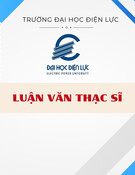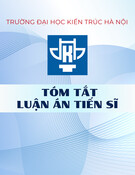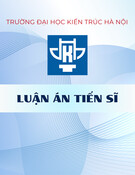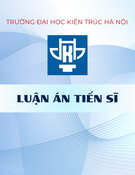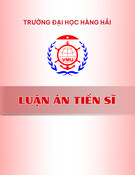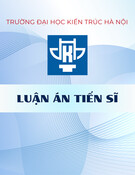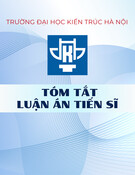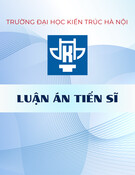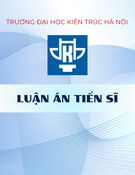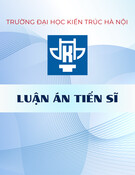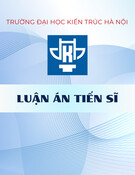
MINISTRY OF EDUCATION
AND TRAINING
VIETNAM ACADEMY OF
SCIENCE AND TECHNOLOGY
GRADUATE UNIVERSITY OF SCIENCE AND
TECHNOLOGY
-----------------------------
Phan Thi Tra My
OPTIMIZATION OF ENERGY FLOW IN
PORT-CONTROLLED HAMILTONIAN SYSTEM
Major: Mechanical engineering
Code: 9520101
SUMMARY OF MECHANICAL ENGINEERING
DOCTORAL THESIS
Ha Noi – 2020

The work was completed at: Graduate University of Science and
Technology - Vietnam Academy of Science and Technology.
Science instructor 1: Assoc.Prof. Dr. La Duc Viet
Science instructor 2: Dr. Luu Xuan Hung
Reviewer 1: ...
Reviewer 2: ...
Reviewer 3:….
The thesis will be defended in the Academy-level doctoral thesis
evaluation council, meeting at the Graduate University of Science
and Technology - Vietnam Academy of Science and Technology
at… o'clock .. ', date… month ... in 2020
The thesis can be found at:
- Library of Graduate University of Science and Technology
- National Library of Vietnam

1
INTRODUCTION
1.The urgency of the thesis
Oscillation control technologies are becoming the base technology
for the development of constructions, mechanical systems, with
applications from medium-sized systems such as vehicles, robots,
rotors, to large systems such as skycrapers, bridges, tunnels ...
In terms of energy, vibration control can be divided into three types:
passive control, semi-active control and active control. The properly
essence of the oscillation control problem is to optimize the flow of
oscillating energy drawn from the controlled system. This is a
research direction with many applications. The selection of thesis in
the direction of "Optimizing the energy flow in controlling
mechanical system oscillation" aims to initially approach this
method.
2. The objectives of the thesis
The main objective of the thesis is to provide general methods to
control oscillation based on measurement of energy flow, namely:
- Find the optimal solution for passive control systems based on
energy flows
- Propose the semi-active control algorithms to control the energy
flow
3. The main research content of the thesis
Research objects:
- The vibration isolation of a single degree of freedom system
- The quarter car model with two degrees of freedom
- Tuned mass damper (TMD) for single degrees of freedom system
- TMD for multiple degrees of freedom system

2
Scope of the research: passive and semi-active control for specific
objects mentioned above, in case of harmonic excitation.
Research methods
- Use power flow criteria: solve min-max problems, find optimal
parameters in the passive control case or control algorithms in semi-
active case.
- Time-shifting technique, harmonic balancing method: used to find
the performance index of the designed controller and the lower
bound solution, thereby correcting the control law
- Numerical simulation by Matlab software: used to evaluate the
effectiveness of analytical solutions and control algorithms.
Layout of the thesis: The thesis consists of 4 chapters, introduction
and conclusion
Chapter 1. Overview of research issues. This chapter presents an
overview of oscillation control methods and basic energy flow
formulas.
Chapter 2. Controlling the power flow in the isolator.
Chapter 3. Controlling the power flow in the quarter car model
Chapter 4. Controlling the power flow in the tuned mass damper.
General conclusions. Present the main results obtained in the thesis,
new points and next major research directions.

3
CHAPTER 1. OVERVIEW
This chapter classifies the control methods based on energy and
limits the scope of the methods used in the thesis. The basic systems
of the PCH system (Port Controlled Hamilton System) were
introduced to describe the dynamics systems and the energy flow
equations in these systems.
1.1. Vibration control
The control methods base on energy include passive, active and
semi-active control. In fact, the control of variation depends on the
nature, characteristics and also on the cost (due to the active control
with high cost) of each specific project. This thesis studies only
passive and semi-active control.
1.2. Energy flow analysis
The variable studied in energy flow analysis is a combination of
effects due to force, velocity, and their product, power, ie the rate of
energy change. This combination plays a role as a unique parameter
to describe the dynamics and responses of a system, including and
reflecting fully the equilibrium and motion of the system. Therefore
overcome limitations in the study of separate displacement response
and force response.
1.3. PCH (Port- Controlled Hamiltonian Systems)
The classic Hamilton system can be rewritten in the following form
( )
H
z
H
z
=+
=
T
z J - R Gu
yG
(1.5)
where z is the system state, H is the Hamiltonian function, u is the
input of the system, G is the input distribution matrix, J satisfying

